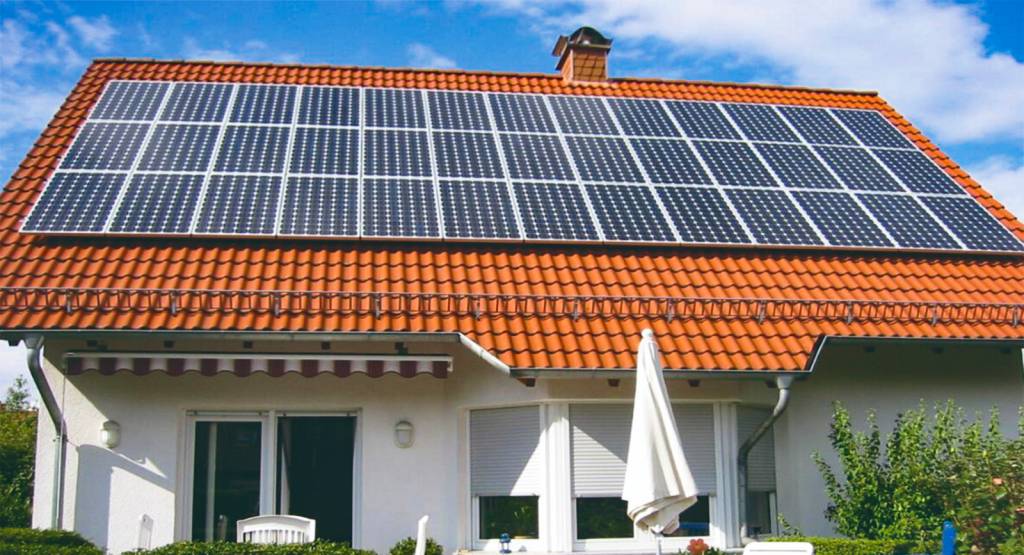Home energy storage systems, as an important part of home energy management, aim to achieve home power self-sufficiency, optimize energy use, and address challenges such as power supply interruptions. According to the different ways of connecting to the power grid, the home energy storage system is mainly divided into two kinds: grid-connected home energy storage system and off-grid home energy storage system.
Grid-connected home energy storage system:
Grid-connected home energy storage system consists of the following five parts:
- Solar arrays: As the core part of the system, solar arrays are responsible for converting solar light energy into direct current energy. Its conversion efficiency, durability, and maintenance costs are key factors to consider when choosing a solar array.
- Grid-connected inverter: The main role of the inverter is to convert the direct current generated by the solar array into alternating current in order to be compatible with home electrical equipment. The grid-connected inverter is also responsible for monitoring and managing the operating status of the system to ensure the safety and stability of the system.
- BMS Management system: The battery management system (BMS) is responsible for monitoring the status of the battery pack, including the battery voltage, current, temperature and remaining power. BMS is also responsible for balancing the charge and discharge of the battery to ensure its safety and long life.
- Battery pack: The battery pack is a place to store electrical energy, and its capacity, type and performance directly affect the energy storage capacity and service life of the home energy storage system. Common battery types include lead-acid batteries, lithium-ion batteries, and so on.
- Ac load: Household electrical equipment, such as lamps, televisions, refrigerators, etc., constitute an AC load. Grid-connected home energy storage systems supply power to these devices through inverters to achieve home power self-sufficiency.
Working mode:
· Mode 1: photovoltaic provides energy storage and surplus electricity for Internet access. When the sun is bright enough, part of the electricity generated by the solar array is used to meet the needs of the home, and the other part is stored in the battery pack. If there is excess power, it is transmitted to the public grid through grid-connected inverters.
· Mode 2: photovoltaic provides energy storage and power consumption for some users. In this case, the electricity generated by the solar array first meets the needs of the home, and the excess energy is stored in the battery pack. If the battery pack is also full, the excess power can be fed into the public grid.
· Mode 3: PV only provides partial energy storage. In this mode, the electricity generated by the solar array is mainly used to meet the household electricity demand and stored in the battery pack, and does not send electricity to the public grid.
In short, grid-connected home energy storage system through reasonable configuration and management, can achieve home power self-sufficiency, energy saving and emission reduction and to deal with power supply interruption and other multiple goals, for home energy management has brought new solutions.
Off-grid home energy storage system:
An off-grid home energy storage system is a completely independent power system that is not connected to the public grid. Therefore, it is not affected by the interruption of power supply from the grid, providing a reliable power supply to the household. The core components of an off-grid home energy storage system differ from a grid-connected system in that it does not require a grid-connected inverter to interact with the grid.
Main components:
- Solar arrays: Also a key part of converting solar energy into direct current.
- Photovoltaic inverter: In off-grid systems, photovoltaic inverters are not only responsible for converting direct current to alternating current for home use, but also manage the charging process of the battery pack.
- BMS management system: The same as the grid-connected system, BMS manages the status of the battery pack to ensure the safe and efficient operation of the battery.
- Battery pack: Store electrical energy for the home to use when there is no sunlight or when electricity demand peaks.
- Ac load: household electrical equipment.
Working mode:
· Mode 1: Photovoltaic provides energy storage and user electricity (sunny days). On a sunny day, the electricity generated by the solar array is supplied directly to the home and simultaneously charges the battery pack.
· Mode 2: photovoltaic and energy storage batteries provide electricity for users (cloudy days). On cloudy days, although the solar energy production is reduced, the battery pack can release the previously stored electrical energy, together with the electricity generated by photovoltaic for home use.

· Mode 3: Energy storage battery provides power to users (in the evening and rainy days). When the sun goes down or when it rains, the photovoltaic system no longer generates electricity, and at this time it completely relies on the battery pack to provide electricity to the home.
Because off-grid home energy storage systems are completely independent of the grid, they are particularly suitable for areas where the grid is unstable or inaccessible. However, this also means that households must rely on the energy storage capacity of the system to meet the electricity demand at night and in bad weather conditions, so there are higher requirements for the capacity of the battery pack and management system.
In summary, off-grid home energy storage systems provide a reliable power solution for households that are unable or unwilling to rely on the public grid. With proper planning and management, it can ensure that homes have access to the power they need in any weather and at any time.
In response to the needs of home energy storage equipment, especially key components such as BMS battery management systems, photovoltaic grid-connected inverters and energy storage inverters, Deli Times has proposed a complete set of power solutions for control units. The scheme fully considers the safety isolation characteristics of each unit circuit of the photovoltaic system to ensure the stability and safety of the system.
